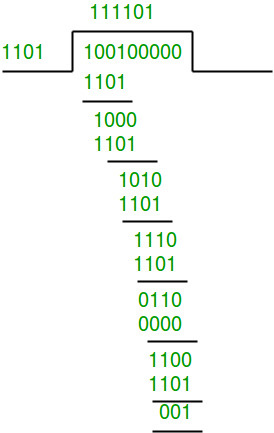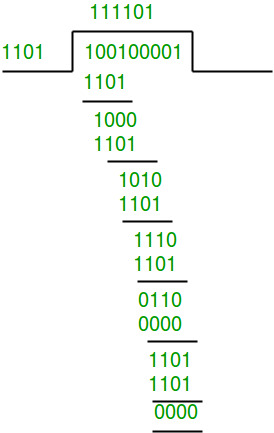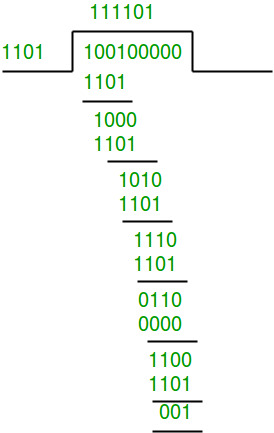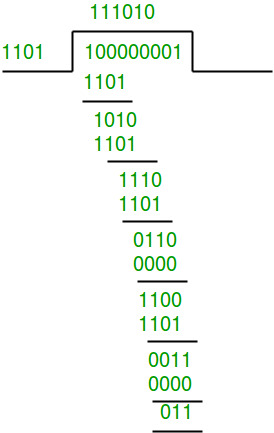CRC或循环冗余校验是一种检测通信信道中意外更改/错误的方法。
CRC使用生成器多项式,在发送方和接收方均可使用。示例生成器多项式的形式类似于x 3 + x +1。此生成多项式表示键1011。另一个示例是x 2 +1,表示键101。
n : Number of bits in data to be sent
from sender side.
k : Number of bits in the key obtained
from generator polynomial.发送方(从数据和生成多项式(或密钥)生成编码数据):
- 首先通过在数据末尾添加k-1个零来扩充二进制数据
- 使用modulo-2二进制除法可通过键对二进制数据进行除法并存储除法的余数。
- 在数据末尾附加其余部分以形成编码数据并发送相同的数据
接收方(检查传输中是否引入了错误)
再次执行模2除法,如果余数为0,则没有错误。
在本文中,我们将仅着重于查找余数,即校验字和代码字。
模2部门:
模2二进制除法的过程与我们用于十进制数的常见除法过程相同。只是,我们在这里使用XOR而不是减法。
- 在每个步骤中,将除数(或数据)的副本与除数(或键)的k位进行异或。
- XOR操作的结果(余数)为(n-1)位,将其拉低1位以使其为n位长后,将用于下一步。
- 当没有剩余可下拉的位时,我们得到结果。 (n-1)位余数附加在发送方。
插图:
示例1(传输无错误):
Data word to be sent - 100100
Key - 1101 [ Or generator polynomial x3 + x2 + 1]
Sender Side:
Therefore, the remainder is 001 and hence the encoded
data sent is 100100001.
Receiver Side:
Code word received at the receiver side 100100001
Therefore, the remainder is all zeros. Hence, the
data received has no error.示例2 :(传输错误)
Data word to be sent - 100100
Key - 1101
Sender Side:
Therefore, the remainder is 001 and hence the
code word sent is 100100001.
Receiver Side
Let there be an error in transmission media
Code word received at the receiver side - 100000001
由于余数不是全零,因此错误
在接收器侧被检测到。
执行
下面是根据给定的二进制数据和密钥生成代码字的实现。
C++
#include
using namespace std;
// Returns XOR of 'a' and 'b'
// (both of same length)
string xor1(string a, string b)
{
// Initialize result
string result = "";
int n = b.length();
// Traverse all bits, if bits are
// same, then XOR is 0, else 1
for(int i = 1; i < n; i++)
{
if (a[i] == b[i])
result += "0";
else
result += "1";
}
return result;
}
// Performs Modulo-2 division
string mod2div(string divident, string divisor)
{
// Number of bits to be XORed at a time.
int pick = divisor.length();
// Slicing the divident to appropriate
// length for particular step
string tmp = divident.substr(0, pick);
int n = divident.length();
while (pick < n)
{
if (tmp[0] == '1')
// Replace the divident by the result
// of XOR and pull 1 bit down
tmp = xor1(divisor, tmp) + divident[pick];
else
// If leftmost bit is '0'.
// If the leftmost bit of the dividend (or the
// part used in each step) is 0, the step cannot
// use the regular divisor; we need to use an
// all-0s divisor.
tmp = xor1(std::string(pick, '0'), tmp) +
divident[pick];
// Increment pick to move further
pick += 1;
}
// For the last n bits, we have to carry it out
// normally as increased value of pick will cause
// Index Out of Bounds.
if (tmp[0] == '1')
tmp = xor1(divisor, tmp);
else
tmp = xor1(std::string(pick, '0'), tmp);
return tmp;
}
// Function used at the sender side to encode
// data by appending remainder of modular division
// at the end of data.
void encodeData(string data, string key)
{
int l_key = key.length();
// Appends n-1 zeroes at end of data
string appended_data = (data +
std::string(
l_key - 1, '0'));
string remainder = mod2div(appended_data, key);
// Append remainder in the original data
string codeword = data + remainder;
cout << "Remainder : "
<< remainder << "\n";
cout << "Encoded Data (Data + Remainder) :"
<< codeword << "\n";
}
// Driver code
int main()
{
string data = "100100";
string key = "1101";
encodeData(data, key);
return 0;
}
// This code is contributed by MuskanKalra1 Python3
# Returns XOR of 'a' and 'b'
# (both of same length)
def xor(a, b):
# initialize result
result = []
# Traverse all bits, if bits are
# same, then XOR is 0, else 1
for i in range(1, len(b)):
if a[i] == b[i]:
result.append('0')
else:
result.append('1')
return ''.join(result)
# Performs Modulo-2 division
def mod2div(divident, divisor):
# Number of bits to be XORed at a time.
pick = len(divisor)
# Slicing the divident to appropriate
# length for particular step
tmp = divident[0 : pick]
while pick < len(divident):
if tmp[0] == '1':
# replace the divident by the result
# of XOR and pull 1 bit down
tmp = xor(divisor, tmp) + divident[pick]
else: # If leftmost bit is '0'
# If the leftmost bit of the dividend (or the
# part used in each step) is 0, the step cannot
# use the regular divisor; we need to use an
# all-0s divisor.
tmp = xor('0'*pick, tmp) + divident[pick]
# increment pick to move further
pick += 1
# For the last n bits, we have to carry it out
# normally as increased value of pick will cause
# Index Out of Bounds.
if tmp[0] == '1':
tmp = xor(divisor, tmp)
else:
tmp = xor('0'*pick, tmp)
checkword = tmp
return checkword
# Function used at the sender side to encode
# data by appending remainder of modular division
# at the end of data.
def encodeData(data, key):
l_key = len(key)
# Appends n-1 zeroes at end of data
appended_data = data + '0'*(l_key-1)
remainder = mod2div(appended_data, key)
# Append remainder in the original data
codeword = data + remainder
print("Remainder : ", remainder)
print("Encoded Data (Data + Remainder) : ",
codeword)
# Driver code
data = "100100"
key = "1101"
encodeData(data, key)C++
// C++ Program to generate CRC codeword
#include
#include
#include
using namespace std;
// function to convert integer to binary string
string toBin(long long int num){
string bin = "";
while (num){
if (num & 1)
bin = "1" + bin;
else
bin = "0" + bin;
num = num>>1;
}
return bin;
}
// function to convert binary string to decimal
long long int toDec(string bin){
long long int num = 0;
for (int i=0; i= gen) || (shft >= 0)){
// bitwise XOR the MSBs of dividend with generator
// replace the operated MSBs from the dividend with
// remainder generated
rem = (dividend >> shft) ^ gen;
dividend = (dividend & ((1 << shft) - 1)) | (rem << shft);
// change shft variable
shft = (int) ceill(log2l(dividend + 1)) - l_gen;
}
// finally, AND the initial dividend with the remainder (=dividend)
long long int codeword = (dword << (l_gen - 1)) | dividend;
cout << "Remainder: " << toBin(dividend) << endl;
cout << "Codeword : " << toBin(codeword) << endl;
}
int main(){
string dataword, generator;
dataword = "10011101";
generator = "1001";
CRC(dataword, generator);
return 0;
} Python3
# Python3 program to generate CRC codeword
from math import log, ceil
def CRC(dataword, generator):
dword = int(dataword, 2)
l_gen = len(generator)
# append 0s to dividend
dividend = dword << (l_gen - 1)
# shft specifies the no. of least significant
# bits not being XORed
shft = ceil(log(dividend + 1, 2)) - l_gen
# ceil(log(dividend+1 , 2)) is the no. of binary
# digits in dividend
generator = int(generator, 2)
while dividend >= generator or shft >= 0:
# bitwise XOR the MSBs of dividend with generator
# replace the operated MSBs from the dividend with
# remainder generated
rem = (dividend >> shft) ^ generator
dividend = (dividend & ((1 << shft) - 1)) | (rem << shft)
# change shft variable
shft = ceil(log(dividend+1, 2)) - l_gen
# finally, AND the initial dividend with the remainder (=dividend)
codeword = dword << (l_gen-1)|dividend
print("Remainder:", bin(dividend).lstrip("-0b"))
print("Codeword :", bin(codeword).lstrip("-0b"))
# Driver code
dataword = "10011101"
generator = "1001"
CRC(dataword, generator)输出:
Remainder : 001
Encoded Data (Data + Remainder) : 100100001请注意,CRC主要设计用于防止通信信道上常见的错误,而不适用于防止数据有意更改(请参见此处的原因)
使用位操作的实现:
CRC码字的生成也可以使用以下位处理方法来完成:
C++
// C++ Program to generate CRC codeword
#include
#include
#include
using namespace std;
// function to convert integer to binary string
string toBin(long long int num){
string bin = "";
while (num){
if (num & 1)
bin = "1" + bin;
else
bin = "0" + bin;
num = num>>1;
}
return bin;
}
// function to convert binary string to decimal
long long int toDec(string bin){
long long int num = 0;
for (int i=0; i= gen) || (shft >= 0)){
// bitwise XOR the MSBs of dividend with generator
// replace the operated MSBs from the dividend with
// remainder generated
rem = (dividend >> shft) ^ gen;
dividend = (dividend & ((1 << shft) - 1)) | (rem << shft);
// change shft variable
shft = (int) ceill(log2l(dividend + 1)) - l_gen;
}
// finally, AND the initial dividend with the remainder (=dividend)
long long int codeword = (dword << (l_gen - 1)) | dividend;
cout << "Remainder: " << toBin(dividend) << endl;
cout << "Codeword : " << toBin(codeword) << endl;
}
int main(){
string dataword, generator;
dataword = "10011101";
generator = "1001";
CRC(dataword, generator);
return 0;
}
Python3
# Python3 program to generate CRC codeword
from math import log, ceil
def CRC(dataword, generator):
dword = int(dataword, 2)
l_gen = len(generator)
# append 0s to dividend
dividend = dword << (l_gen - 1)
# shft specifies the no. of least significant
# bits not being XORed
shft = ceil(log(dividend + 1, 2)) - l_gen
# ceil(log(dividend+1 , 2)) is the no. of binary
# digits in dividend
generator = int(generator, 2)
while dividend >= generator or shft >= 0:
# bitwise XOR the MSBs of dividend with generator
# replace the operated MSBs from the dividend with
# remainder generated
rem = (dividend >> shft) ^ generator
dividend = (dividend & ((1 << shft) - 1)) | (rem << shft)
# change shft variable
shft = ceil(log(dividend+1, 2)) - l_gen
# finally, AND the initial dividend with the remainder (=dividend)
codeword = dword << (l_gen-1)|dividend
print("Remainder:", bin(dividend).lstrip("-0b"))
print("Codeword :", bin(codeword).lstrip("-0b"))
# Driver code
dataword = "10011101"
generator = "1001"
CRC(dataword, generator)
输出:
Remainder: 100
Codeword : 10011101100参考:
https://zh.wikipedia.org/wiki/Cyclic_redundancy_check